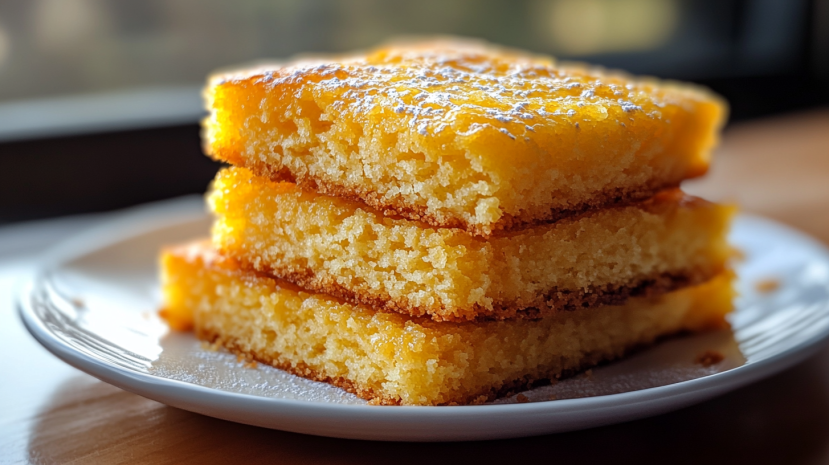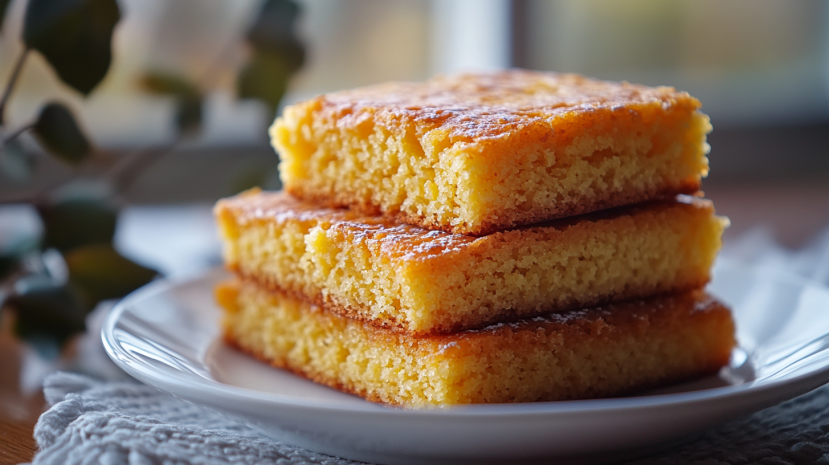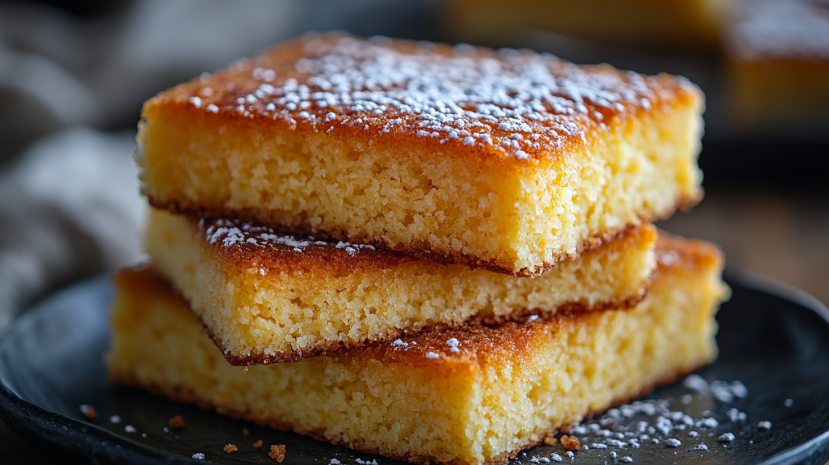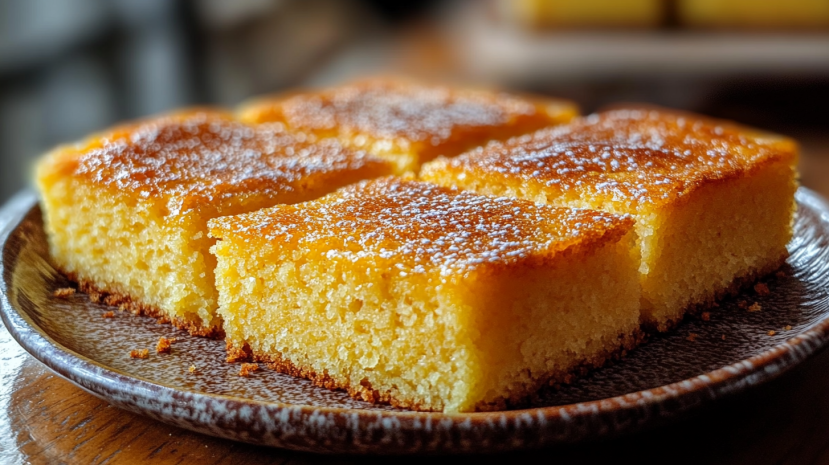At Dish Delice, we’re passionate about creating recipes that are both delicious and nourishing, without compromising on taste. We understand that many of our readers are looking to cut back on sodium for better health, and that’s why we’ve reimagined a beloved classic: Low-Sodium Cornbread. Cornbread has always been a comforting side dish, especially when served with chili or barbecue, but traditional recipes often contain hidden sodium.
As part of our commitment to making healthy eating easy and flavorful, we’ve taken this comforting favorite and crafted a version that fits perfectly into a low-sodium diet. Our Low-Sodium Cornbread recipe replaces high-sodium ingredients with simple, wholesome alternatives, ensuring that you can enjoy all the flavor without worrying about your sodium intake.
Ready to bake a batch of magic? Let’s get started!
Table of Contents
Why Choose Low-Sodium Cornbread?
As part of a healthy lifestyle, reducing sodium intake is important to preventing high blood pressure, heart disease, and other issues. Even most traditional dishes, like cornbread, can be quite high in sodium, particularly if they’re made using commercial mixes or if salt is added in the cooking process. With some simple substitutions, however, you can continue to indulge in the rich taste of cornbread without the sodium.

Health Benefits of a Low-Sodium Cornbread Diet
A low-sodium diet is essential for people who wish to reduce their risk of hypertension (high blood pressure), heart disease, and stroke. Sodium is essential for regulating fluid balance and aiding nerve function, but many individuals consume more than what the body actually needs. The American Heart Association recommends that adults should limit their sodium intake to 2,300 milligrams per day, with 1,500 milligrams being an ideal target for most people. The problem is that many packaged foods, including breads and mixes, often contain far more sodium than most people are aware of.
With homemade low-sodium cornbread, you are in control of how much sodium is put into your food. This single adjustment can have long-term health consequences in that it will enable you to maintain healthy blood pressure and lower your risks for heart disease.
The Importance of Sodium Control
Excessive sodium can lead the body to hold onto water, placing a burden on the heart and blood vessels. Over time, this can lead to hypertension. Excessive sodium intake can also lead to kidney damage, brittle bones, and an elevated risk of stroke. Cooking lower-sodium versions of your favorite foods, like this Low-Sodium Cornbread, enables you to enjoy your meals and keep your sodium levels in check.
With the substitution of sodium-free baking powder and the exclusion of any added salt in the recipe, this cornbread is a much better choice for those who need to watch their sodium intake. It’s not just a pleasure for those with dietary limitations, but for anyone trying to take control of their health and make more aware food choices.
Is It Safe to Have Cornbread on Low-Sodium Diet?
Cornbread is a delicious, comforting dish that pairs well with so many meals. However, if you’re on a low-sodium diet, you find yourself wondering if cornbread can be part of your meal plan. The good news is that low-sodium cornbread is definitely a part of a healthy meal plan. With some changes to traditional recipes, such as the use of sodium-free baking powder and the removal of added salt, you can enjoy cornbread without the worry of excess sodium.
How to Make Low-Sodium Cornbread
To make your cornbread low in sodium, be sure to employ ingredients that are either naturally sodium-free or contain very low levels of sodium. For instance:
Sodium-Free Baking Powder: Most baking powders include sodium, but sodium-free baking powder is available and functions just as well.
No Added Salt: Most recipes call for additional salt, but feel free to leave it out altogether. The flour and cornmeal provide enough flavor as is.
Fresh Ingredients: Avoid pre-packaged mixtures, which often harbor hidden sodium. By making cornbread from scratch, you control the ingredients.
These simple adjustments make it easy to prepare a low-sodium cornbread that easily integrates with a low-sodium program.
Pleasing Cornbread with a Low-Sodium Meal Plan
Adding low-sodium cornbread to your meal plan is not about losing flavor. Serve it with grilled chicken, a vegetable stir-fry, or a nutrient-rich soup, and it becomes a deliciously satisfying complement without the guilt of too much sodium. So, indulge in some low-sodium cornbread as part of a well-balanced and heart-healthy meal.
Does Cornbread Have High Sodium?
Cornbread can be fairly high in sodium, especially when made with old-fashioned recipes or from pre-mixed boxes. While cornbread tends to be a savory dish, most recipes and pre-mixtures contain quite a lot of salt, which increases the sodium content significantly. This makes cornbread not as good of an option for those who are following a low-sodium diet.

How Much Sodium Is in Traditional Cornbread?
A single serving of average cornbread (1 piece or slice) made from a pre-mix may contain 200-300 milligrams of sodium based on brand and recipe. This might not seem like a lot, but when you consume multiple servings or use it in addition to other high-sodium foods on your plate, it can add up fast.
Why Store-Bought Cornbread Mixes Are High in Sodium
Most packaged cornbread mixes contain excess salt, sodium-based baking powder, and sometimes even preservatives. These contribute to the overall sodium load in the final product. Partially hydrogenated oils and processed ingredients can also be present in some mixes that might not be consistent with a healthy eating regimen.
To prepare your own low-sodium cornbread from scratch is to have the ability to determine how much sodium you add, and it is therefore a healthier option when attempting to keep sodium at a minimum.
Making Cornbread Healthier
While you can still include cornbread in your low-sodium diet, it’s best to use a homemade version or purchase mixes that bear low-sodium. By making easy substitutions such as substituting sodium-free baking powder and leaving out the extra salt, you can create a delicious and healthy alternative that won’t negate your low-sodium efforts.
How Much Sodium Is in Jiffy Cornbread Mix?
When it comes to convenience, Jiffy Cornbread Mix is a popular option, but if you’re on a low-sodium diet, you might want to reconsider using it regularly. Pre-packaged mixes, like Jiffy, often contain added salt and preservatives that can raise the sodium content significantly. Understanding the sodium content in these mixes can help you make a more informed decision when preparing cornbread.
Sodium Content in Jiffy Cornbread Mix
A serving of Jiffy low-sodium Cornbread Mix contains about 440 milligrams of sodium, which is a considerable amount for those who are trying to reduce their sodium intake. Given that the American Heart Association recommends a maximum of 2,300 milligrams of sodium per day, just one serving of Jiffy mix takes up a significant portion of your daily sodium allowance.
This may not seem like much for a single slice of low-sodium cornbread, but if you enjoy multiple servings, the sodium can quickly add up, potentially exceeding your daily limit. For individuals with high blood pressure or those managing other health conditions, the sodium in pre-packaged mixes like Jiffy can contribute to a higher-than-recommended intake.
Why Jiffy Cornbread Mix is Not Ideal for a Low-Sodium Diet
While convenient, Jiffy Cornbread Mix contains ingredients like salt and sodium bicarbonate, which increase the sodium levels in the final product. Additionally, many store-bought mixes are highly processed, often containing artificial flavors and preservatives, which may not be suitable for someone looking to eat a more natural, nutrient-dense diet.
For those who are mindful of their sodium intake, it’s best to avoid using mixes like Jiffy and instead opt for homemade recipes, like the low-sodium cornbread recipe we’ve shared earlier, which allows you to control the sodium content and avoid unnecessary additives.
Alternatives to Jiffy Cornbread Mix
If you’re looking for convenience but want to keep the sodium content low, you can find other low-sodium cornbread mixes available on the market. Alternatively, making cornbread from scratch using the simple ingredients in the low-sodium recipe is always the best way to ensure you’re keeping your sodium intake in check while still enjoying a delicious treat.
What Kind of Bread Can You Eat on a Low-Sodium Diet?
When following a low-sodium diet, it’s important to choose breads that are made with minimal sodium and avoid those with added salt or high-sodium ingredients. Many store-bought breads and pre-packaged bread mixes can be surprisingly high in sodium. However, there are plenty of bread options that fit within a low-sodium plan while still being delicious and satisfying.

Choosing the Right Bread for a Low-Sodium Diet
For those on a low-sodium diet, there are a few strategies to consider when selecting bread:
- Look for Low-Sodium Labels: Many bakeries and brands offer low-sodium versions of their bread, clearly labeled for easy identification. These types of low-sodium cornbread often have less than 100 milligrams of sodium per slice.
- Whole Grain or Whole Wheat Bread: Opting for whole grain or whole wheat breads is a good choice for many reasons. Not only are they lower in sodium, but they also provide extra fiber, which is beneficial for heart health. Be sure to check the labels, as some whole-grain breads still contain added salt.
- Homemade Bread: Making your own low-sodium cornbread from scratch allows you to have complete control over the ingredients. By using simple, natural ingredients and skipping the added salt, you can create bread that’s both nutritious and low in sodium.
Types of Low-Sodium Cornbread to Look For
Here are a few specific types of bread that tend to be lower in sodium:
- Sourdough Bread: Many sourdough breads are naturally lower in sodium due to the fermentation process, which doesn’t require added salt.
- Flatbreads: Some types of flatbreads, especially those made without added salt, can be lower in sodium than traditional loaf breads.
- Artisan Breads: Look for artisanal low-sodium cornbread, which are often made in small batches and tend to have less sodium than mass-produced varieties. These breads are typically made with fewer preservatives and additives, making them a better choice for a low-sodium diet.
What to Avoid
- Packaged Breads: Many mass-produced packaged breads can have surprisingly high sodium levels due to preservatives and additives. Always check the sodium content on the nutrition label before purchasing.
- Bread Mixes: Similar to cornbread mixes, bread mixes can also contain high amounts of sodium. Making bread from scratch is always the best way to control the ingredients and ensure your bread fits within your low-sodium diet.
What Kind of Sandwich Can I Eat on a Low-Sodium Diet?
Sandwiches are a popular meal choice for many, but if you’re following a low-sodium diet, it’s important to be mindful of the ingredients you choose. Traditional sandwiches, especially those made with processed meats, cheeses, and store-bought condiments, can be high in sodium. However, with a little creativity and the right ingredient choices, you can still enjoy a delicious sandwich that fits your low-sodium needs.
Low-Sodium Sandwich Ideas
Here are some sandwich options that work well for a low-sodium diet:
- Fresh Vegetable Sandwiches
Fill your sandwich with a generous amount of fresh vegetables such as lettuce, spinach, cucumbers, tomatoes, and bell peppers. These veggies are naturally low in sodium and packed with essential vitamins and fiber. You can enhance the flavor with a splash of olive oil, a little vinegar, or even a touch of mustard for some zest. - Lean Protein Sandwiches
Opt for lean proteins like turkey breast, grilled chicken, or tofu. These proteins are generally lower in sodium compared to processed deli meats like ham or salami, which can be very high in salt. Be sure to look for low-sodium or no-salt-added options when purchasing meats. - Egg Salad Sandwich
An egg salad made with hard-boiled eggs, a small amount of low-fat mayo or Greek yogurt, and fresh herbs like chives or dill can be a great option. Just make sure to use minimal salt in the recipe, as eggs themselves are naturally low in sodium. - Hummus and Veggie Sandwich
Hummus is a delicious low-sodium spread made from chickpeas, tahini, and olive oil. Spread hummus on whole grain low-sodium cornbread and top it with fresh vegetables like cucumbers, tomatoes, and leafy greens. This is a filling and flavorful option that won’t break your sodium budget. - Avocado and Turkey Wrap
If you prefer wraps over traditional bread, consider using a whole-grain tortilla filled with mashed avocado and lean turkey. The avocado contributes a creamy texture and healthy fats, while the turkey offers a good source of protein. This combination is naturally low in sodium and very satisfying.
Avoid These High-Sodium Ingredients in Sandwiches
- Processed Meats
Cured meats such as salami, bologna, and pepperoni are high in sodium. Instead, choose fresh, unprocessed meats like grilled chicken, turkey, or lean beef. - Cheese
Many cheeses, especially processed varieties like American or cheddar, are high in sodium. Opt for reduced-sodium cheese or skip it altogether and load your sandwich with flavorful veggies instead. - Store-Bought Condiments
Ketchup, mustard, mayonnaise, and pickles can contain added salt. Look for low-sodium versions of these condiments, or make your own at home to control the sodium content. - Canned Vegetables
If you’re adding vegetables to your sandwich, make sure they’re fresh or frozen, as canned vegetables often have added salt. Fresh veggies are the healthiest choice.
Making Your Own Low-Sodium Cornbread Sandwich
The key to a low-sodium sandwich is choosing fresh, whole ingredients. By selecting the right type of bread, adding lean proteins, and filling your sandwich with vegetables, you can create a satisfying meal that fits within your low-sodium diet. Don’t forget to check nutrition labels when purchasing low-sodium cornbread, meats, and condiments to ensure they are low in sodium.
Can I Eat Spaghetti on a Low-Sodium Diet and Still Enjoy Low-Sodium Cornbread?
If you’re following a low-sodium diet, you may wonder whether you can still enjoy classic comfort foods like spaghetti while keeping your sodium intake in check. The great news is that you absolutely can! And, if you’re craving a side to go with your spaghetti, low-sodium cornbread is the perfect choice to accompany your meal.

How to Enjoy Spaghetti on a Low-Sodium Diet with Low-Sodium Cornbread
- Choose Whole-Grain or Gluten-Free Pasta for Low-Sodium Meals
For a low-sodium diet, whole-grain or gluten-free pasta is an excellent option. It’s naturally low in sodium and adds fiber to your meal, complementing your low-sodium cornbread perfectly. Whole-grain pasta provides a hearty base for your low-sodium spaghetti without any added sodium. - Make Your Own Low-Sodium Tomato Sauce
Pre-made sauces can be high in sodium, but making your own low-sodium tomato sauce is simple and delicious. By using fresh tomatoes, garlic, onions, and herbs, you can craft a sauce that’s packed with flavor but won’t overwhelm your sodium limits. Pair it with low-sodium cornbread for a balanced meal that keeps sodium in check. - Add Lean Protein for a Healthy Low-Sodium Spaghetti
For your spaghetti, choose lean proteins like chicken, turkey, or tofu. These proteins are naturally low in sodium and complement your low-sodium cornbread perfectly. Avoid processed meats such as sausage or pepperoni, as they contain high levels of sodium that may disrupt your low-sodium diet. - Limit or Skip the Cheese
Cheese is frequently used as a topping for spaghetti, but it tends to be high in sodium. For a healthier option, skip the cheese or use a reduced-sodium variety. The absence of salty cheese allows your low-sodium cornbread to shine as a side dish that complements the pasta without adding extra sodium to the meal.
Avoid High-Sodium Ingredients in Your Low-Sodium Diet
- Canned Spaghetti Sauces
Most canned spaghetti sauces contain added salt, which can quickly increase the sodium content of your meal. By making your own sauce and pairing it with homemade low-sodium cornbread, you control the sodium and can enjoy a flavorful, healthier dish. - Processed Meats
For a low-sodium meal, avoid processed meats like salami, bologna, or pre-packaged sausage, as these are high in sodium. Fresh, lean protein will help you maintain your low-sodium diet, and when paired with a slice of low-sodium cornbread, it makes for a complete and satisfying meal. - Skip Canned Vegetables
Canned vegetables often have added sodium, so opt for fresh or frozen vegetables to keep your spaghetti and low-sodium cornbread meal as low in sodium as possible.
Low-sodium spaghetti and cornbread make an ideal combination for anyone on a low-sodium diet.
With the right adjustments, you can enjoy a hearty plate of spaghetti without exceeding your sodium limits. Enjoy your spaghetti with a side of low-sodium cornbread for a heart-healthy and satisfying meal. Preparing your own low-sodium tomato sauce with fresh ingredients and selecting low-sodium pasta helps keep your meal aligned with your dietary goals.
So yes, it’s entirely possible to have low-sodium cornbread alongside your spaghetti while staying within your low-sodium diet, all without sacrificing flavor or satisfaction!
Can I Eat Pizza on a Low-Sodium Diet?
Pizza is a favorite for many, but if you’re on a low-sodium diet, you might be concerned about how it fits into your eating plan. The good news is, you can still enjoy pizza, even on a low-sodium diet, by making a few thoughtful adjustments. By choosing the right ingredients and avoiding high-sodium toppings, you can create a delicious and healthier version of pizza that fits within your sodium goals.
How to Enjoy Pizza on a Low-Sodium Diet
- Use a Homemade or Low-Sodium Crust
Store-bought pizza dough can sometimes be high in sodium, so it’s a good idea to make your own crust. By preparing a simple dough from scratch, you can avoid the hidden sodium in pre-packaged crusts. Alternatively, look for a low-sodium pizza crust available at health food stores for a quick and easy option. - Choose a Low-Sodium Tomato Sauce
Pizza sauce is often packed with salt, so making your own sauce is the best way to control the sodium content. A simple homemade sauce with fresh tomatoes, garlic, oregano, and basil can be a flavorful and low-sodium alternative to store-bought pizza sauces. - Go Light on the Cheese
Cheese can contribute a significant amount of sodium to your pizza. To keep it low-sodium, you can use a smaller amount of reduced-sodium cheese or skip the cheese altogether. You can also experiment with dairy-free alternatives or opt for fresh mozzarella, which tends to have less sodium than pre-shredded varieties. - Top with Fresh Vegetables and Lean Proteins
Instead of using processed meats like pepperoni or sausage, which are often high in sodium, try topping your pizza with fresh vegetables like bell peppers, mushrooms, onions, and spinach. For added protein, you can use grilled chicken or turkey breast, both of which are lower in sodium compared to traditional pizza toppings.
Avoid High-Sodium Ingredients on Pizza
- Processed Meats
Processed meats such as pepperoni, sausage, and bacon are notorious for being high in sodium. For a healthier pizza, opt for lean meats like chicken or turkey, or skip the meat altogether and load your pizza up with fresh veggies. - Store-Bought Sauces and Pre-Shredded Cheese
Many store-bought pizza sauces and pre-shredded cheeses contain added sodium. Always check the labels, or better yet, make your own sauce and choose fresh cheese that is lower in sodium. - Canned Vegetables
While convenient, canned vegetables often come with added salt. Choose fresh or frozen vegetables to top your pizza and keep the sodium content low.
Low-Sodium Pizza for a Heart-Healthy Diet
Making a few simple changes can allow you to enjoy pizza without exceeding your sodium limits. Homemade pizza crust, low-sodium sauce, fresh toppings, and lean proteins can help create a meal that fits within your low-sodium diet. So, go ahead and enjoy a slice of low-sodium pizza alongside your low-sodium cornbread for a satisfying, heart-healthy meal!
Conclusion
Maintaining a low-sodium diet doesn’t mean sacrificing flavor or comfort foods. With simple modifications, you can enjoy a variety of meals, including low-sodium cornbread, low-sodium spaghetti, and even low-sodium pizza, while still meeting your dietary goals. By opting for homemade sauces, choosing fresh and lean ingredients, and carefully selecting sodium-free or reduced-sodium alternatives, you can create meals that are both satisfying and heart-healthy.
Remember, the key to a successful low-sodium diet is making mindful choices with the foods you enjoy, and low-sodium cornbread is a great example of how you can keep comfort foods within a healthier, heart-conscious plan. So, go ahead—make that batch of low-sodium cornbread, pair it with your favorite dishes, and enjoy a delicious, sodium-conscious meal without compromising taste or satisfaction.
For more recipe follow me on Pinterest and Facebook.
FAQs
Can you eat cornbread on a low-sodium diet?
Yes, you can enjoy cornbread on a low-sodium diet by making it from scratch using sodium-free baking powder and skipping the added salt. Traditional cornbread recipes can be high in sodium, but by adjusting the ingredients, you can create a healthier version that fits within your low-sodium dietary plan.
Does cornbread have high sodium?
Traditional cornbread can have a high sodium content, especially when made with store-bought mixes that often contain added salt. However, if you make cornbread from scratch and use low-sodium or sodium-free ingredients, you can easily reduce its sodium content.
How much sodium is in Jiffy cornbread mix?
A serving of Jiffy Cornbread Mix contains about 440 milligrams of sodium. For individuals on a low-sodium diet, this can quickly add up, making it a less ideal option. Opting for homemade low-sodium cornbread is a better choice for controlling sodium intake.
What kind of bread can you eat on a low-sodium diet?
For a low-sodium diet, you can choose whole-grain bread, homemade bread without added salt, or look for pre-made low-sodium bread options. Avoid breads that are processed or contain high amounts of salt, which are commonly found in packaged loaves and bread mixes.
What kind of sandwich can I eat on a low-sodium diet?
For a low-sodium cornbread sandwich, use low-sodium bread and fill it with fresh, natural ingredients like lean turkey, chicken, or vegetables. Avoid processed deli meats, cheeses, and condiments that can be high in sodium. You can also use low-sodium or homemade spreads like hummus or avocado.
Can I eat spaghetti on a low-sodium diet?
Yes, you can enjoy spaghetti on a low-sodium diet by choosing whole-grain or gluten-free pasta, making your own low-sodium sauce, and using fresh, lean proteins. Avoid canned sauces, which are often high in sodium, and skip the processed meats like sausage or pepperoni.
Can I eat pizza on a low-sodium diet?
Pizza can still be part of a low-sodium diet if you make it at home with sodium-free or low-sodium ingredients. Use a homemade crust, low-sodium sauce, fresh veggies, and lean proteins like chicken or turkey. Avoid using processed meats and high-sodium cheeses to keep your pizza heart-healthy.